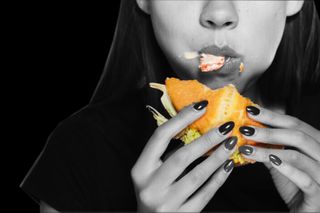
Eating to Gain Weight Isn’t Always Healthy, But More Women Are Doing It
As body ideals have changed, the extremes we take to achieve them haven’t.

Kashish Attri was 16 the first time she remembers feeling small.
“I wanted to drive a Harley. [A male friend] just looked at me and said, ‘you’re too small,’ which basically meant you won’t be able to handle the weight. I just felt the need to grow bigger to handle stuff, so that tomorrow when [say] I move out of the house, I won’t need someone to move boxes for me.”
Attri sought permission from her father to join a gym — “like any Indian father, the first thing he said was ‘No, girls don’t do that’.” But Attri lied and said her desire to work out was about managing the anger she felt over her mother’s recent death. He relented, and she walked into a gym days later, telling a trainer there, “I want to grow. I want to grow muscle.”
He didn’t understand until she added, “like a boy.”
After that, Attri’s eating habits totally changed to complement her workouts. “As soon as I started gymming, my trainer told me what to eat and what not to. And I followed that very religiously.” She started taking protein powder. A lifelong vegetarian, she started eating meat. She refused to eat anything ‘unhealthy,’ even if it meant skipping meals while out and about with friends and family.
Disordered eating is different from an eating disorder. The latter is a clinical diagnosis of a mental health problem that manifests in extreme food restriction and weight control; it is thought to affect 1% to 3% of the global population. By contrast, research suggests as many as one in two people display disordered, unhealthy habits when it comes to food, body image and exercise. For some, disordered eating is aimed at losing weight. But for a small, overlooked segment, it’s aimed at getting bigger; a new study out of the University of California, San Francisco, suggests 22% of men and 5% of women between ages 18 and 24 specifically shape their eating to bulk up. (No research has been conducted on the subject in India.)
Eating to gain weight and bulk up is often interpreted as an effort to be more healthy or fit — which makes unhealthy habits difficult to spot and even more difficult to dispute.
When Attri started seeing the difference in her body — bigger shoulders, sculpted arms — she redoubled her efforts.
“Now that I look back, I can see that I was shaping my life around it,” she says. “In that moment, all of this felt – ‘Oh, I’m getting bigger. This is so nice.’ But now, looking back, it makes me realize how much I changed as a person.”
Changes to the body accrue over time. Weight loss and muscle building are incremental, painstaking affairs. So, too, are changes to body ideals; individual minds take time to adjust and reach a critical mass that collectively worships at a new altar. Today’s ‘ideal’ female body, while still thin, looks very different — with its toned arms, shoulders, thighs and abs — from that of the 90s and pre-Instagram 2000s waiflike It Girls. Thinspo gave way to fitspo (which, as of writing, is the tag for 66.9 million posts on Instagram), but the pressure and the extremes by which one can alter one’s diet to achieve some ideal stayed the same.
“Earlier, it was being thin, so it was cutting down on food completely. Now, it’s being fit, so ‘I only can eat certain kinds of food’,” says Shachi Dalal, a Mumbai-based therapist specializing in eating disorder treatment, among other forms of therapy, and who has previously written for The Swaddle. Dalal frequently treats patients with disordered eating habits. She says extreme eating and exercise regimens aimed at ‘bulking up’ are most common among patients in their late teens and early-to-mid 20s. “I have seen it more among men, but I’ve seen a lot of women coming in with this [desire] of ‘I want to be muscular. I want to be fit’.”
Related on The Swaddle:
The Unique Factors That Contribute to Eating Disorders in India
Eating to bulk up tends to be very disciplined, Dalal says. While the web is rife with advice on how to eat to get bigger, most bodybuilding diets are typically structured in strict phases or intervals. In the first, all fats are cut from a diet. In the second, protein consumption skyrockets. “What happens is, when they follow these kinds of patterns, they have to be extremely regimented,” Dalal says. “[There’s] a fine line between when this [effort] becomes an obsession.”
Regardless of whether the goal is to be smaller or bigger, the thing that makes an individual’s dietary habits disordered is that “they base a lot of their self-worth on their ability to control their shape, their weight, their eating habits,” Dalal says. She points to media and culture as the driving forces behind an unhealthy obsession with a healthy appearance. From Instagram’s thousands of fitness influencers, to Bollywood’s increasing muscle definition among its current crop of stars (compared to, say, those of a decade ago), the message is: this is the right kind of body, here are all of the ways you can achieve it, and it’s good to commit your time and energy to doing so.
“The only reason I felt I had to get bigger was because I felt really vulnerable.”
Comparison seems to be a critical turning point in most people’s step toward disordered eating, but it’s not always comparison to the faraway social media influencer and Bollywood heartthrob that prompts the need to bulk up. For Sadhika Burman, it was a comparison of her body to the development of her adolescent compatriots on the swim team.
“Looking at my teammates’ bodies that were already growing would make me feel helpless. Because there was nothing I could do about it. I started shaping my diet and [wearing] clothes [that would make me] look bigger from as young as a 15-year-old,” remembers the now-22-year-old, who grew up in Chandigarh. “It’s funny how frowning upon smaller boobs or a smaller wrist or waist was so normalized. I remember wishing all the time for a ‘normal’ body. And normal for me then was bigger boobs, larger waist, chubbier arms and wrists.”
Burman devoted herself to researching how to get bigger. She began taking protein supplements. She drank more milk. And she remembers “just trying to eat all the time, regardless of me liking it or not,” she says. “I still feel the horrible aftertaste of mass gainers.”
For Attri, however, it wasn’t a comparison of her body to other women’s bodies that drove her to excess — but rather, her body to men’s.
“I am a short person. I’m five-two. I looked like a tall girl in Grade 5 or 6. Then, every guy I knew grew taller,” she says. She has a brother and has seen up close the strength and physicality of men fighting, says the Delhi native. And she pays attention to the news, which is filled with reports of violence against women. “Guys around me, they always tell me ‘Look at how tiny you are. You can’t do shit even if you want to.’ It made me think of situations where things could go wrong for me.
“The only reason I felt I had to get bigger was because I felt really vulnerable.”
The end-goal of exercising and eating to bulk up is often what gets in the way of recognizing the unhealthiness of the habits. In a world plagued by increasingly sedentary lifestyles and associated diseases, it’s difficult to stand in the way of efforts toward better health. But for women, it’s not just about getting healthier by being more fit — it’s about becoming more powerful. In a country where so many women feel failed and hunted, it’s difficult to argue against self-sufficiency. In a society where so few girls are encouraged to play sports, it’s difficult to discourage a young, female athlete’s drive to keep up. But at the end of the day, “it’s still disordered eating. The main issue becomes when you revolve everything around that particular thing. You revolve your self-worth, you revolve your time,” Dalal says.
Helping people who eat to get big is “about raising awareness,” Dalal says. “It’s about saying, ‘This presentation, while it may look okay on the outside, could have people struggling on the inside. and it’s important to know.”
Over the past year, Attri has gained weight due to polycystic ovarian disorder (PCOD). And focusing on her studies has left her less time for gymming. The now-19-year-old’s body is no longer so ‘fit’ or muscular as it was in the heyday of her efforts. But that might be okay.
“I’ve been fat-shamed and I’ve been thin-shamed. … No matter how much I gained, or no matter how much bulkier or how fit I looked, people told me I looked like a man. People tell me now I look too girly,” she reflects. “Everything you do has to be associated if it’s masculine or feminine enough.”
But none of that matters anymore, she adds. “What matters is I’m healthy and I can keep myself healthy.
“I realized my body is going to fluctuate a lot. It’s going to get bigger and it’s going to get smaller. But it’s important for me to accept myself the way I am because no one else will.”
Related:
Liesl Goecker is The Swaddle's managing editor.
Related


Indian Women Are 35% More Likely to Go Blind of Cataracts
